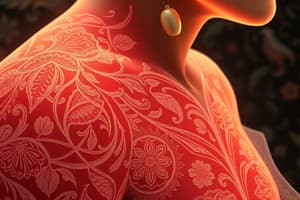Podcast
Questions and Answers
What is the relationship between the ultimate tensile strength and yield strength in a brittle adhesive?
What is the relationship between the ultimate tensile strength and yield strength in a brittle adhesive?
- Lower than the yield strength
- Close, or the same as the yield strength (correct)
- Much higher than the yield strength
- Much lower than the yield strength
Why is the single lap shear test a popular method of testing adhesively bonded joints?
Why is the single lap shear test a popular method of testing adhesively bonded joints?
- It is cheap and simple to perform (correct)
- Bond line thickness and load rates will not affect the results
- It accurately represents the true shear strength of the adhesive
- The adhesive is subjected to uniform stress across the joint
Based on the accompanying stress/strain curve, what type of fractures are represented?
Based on the accompanying stress/strain curve, what type of fractures are represented?
- Brittle (A) and buckling (B)
- Ductile (A) and plastic (B)
- Plastic (A) and elastic (B)
- Brittle (A) and ductile (B) (correct)
Which of the following list of failure modes matches the accompanying figure?
Which of the following list of failure modes matches the accompanying figure?
What is a common factor that can lead to an adhesive failure mode?
What is a common factor that can lead to an adhesive failure mode?
What is the definition of a thermoplastic adhesive?
What is the definition of a thermoplastic adhesive?
What is the purpose of adding particle fillers to an adhesive?
What is the purpose of adding particle fillers to an adhesive?
What is the term for a substance added to an adhesive to improve flexibility, reduce brittleness, and decrease viscosity?
What is the term for a substance added to an adhesive to improve flexibility, reduce brittleness, and decrease viscosity?
Flashcards are hidden until you start studying
Study Notes
Adhesive Properties
- In a brittle adhesive, the ultimate tensile strength is much lower than the yield strength.
- The ultimate tensile strength is not always the same as the yield strength.
Testing Adhesives
- The single lap shear test is a popular method for testing adhesively bonded joints because it is cheap and simple to perform.
- The test does not accurately represent the true shear strength of the adhesive, and the adhesive is not subjected to uniform stress across the joint.
- Bond line thickness and load rates can affect the results of the single lap shear test.
Fracture Types
- Based on a stress/strain curve, brittle fractures can be identified.
- Brittle fractures are different from ductile and plastic fractures.
Failure Modes
- Failure modes can be categorized as cohesive, inter-facial, mixed-mode, or brittle.
- Adhesive, cohesive, and substrate failures are different types of failure modes.
- Mixed-mode failure is a type of failure mode.
Causes of Adhesive Failure
- Improper preparation of the substrate surface can lead to adhesive failure.
- Excessive bond-line thickness and defects in the adhesive layer can also cause adhesive failure.
- Consistent bond-line thickness is not a cause of adhesive failure.
Thermoplastic Adhesives
- Thermoplastic adhesives are polymer-based adhesives that are applied in a molten state and cure as they cool.
- They can be reversible upon re-heating.
Particle Fillers
- Particle fillers are often used to reduce costs and increase tack.
- They can also reduce viscosity, but this is not their primary purpose.
Additives
- Plasticizers are substances added to adhesives to improve flexibility, reduce brittleness, and decrease viscosity.
- Wetting agents, thickeners, and hardeners are different types of additives.
Material Properties
- Young's modulus is a measure of stress to recoverable strain of a material.
- Poisson's ratio is a different material property.
Material Laws
- Hooke's Law states that the stress imposed on a material, within its elastic limit, is proportional to the strain produced.
- Young's Law, Ohm's Law, and Brinell's Law are different laws.
Studying That Suits You
Use AI to generate personalized quizzes and flashcards to suit your learning preferences.




